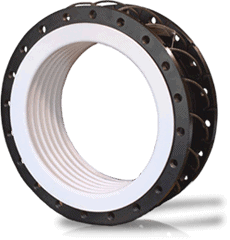FLEXIJOINTS Flex Joints from Ethylene
Flexijoint Expansion Joints with PTFE and Durcor-62
Ethylene Flexijoint PTFE expansion joints are flexible connectors and tremor barriers designed to compensate for misalignment, absorb expansion and contraction, and isolate vibration and shock in process piping, tanks and pumps. They also offer a low spring rate to protect stress sensitive FRP, glass or graphite equipment. Flexijoints are available in sizes 1/2″ to 42″ and from 2 to 12 convolutions for maximum movement. Flexijoint has almost universal chemical inertness, high and low temperature resistance, invulnerability to ozone and sunlight, outstanding flex life, and low acoustical impedance (sound dampening properties).
Flexijoint® Distinctive Features
Pure 100% Virgin PTFE Resin:
The unmatched performance of Flexijoint is due to its exclusive Fluoroforming™ process, a development of Ethylene. The Fluoroforming™ process employs only high molecular weight resin to utilize pure PTFEwith no pigments or additives which might contaminate contacting fluids by leaching out, or to be vulnerable to blistering. In addition, high molecular weight with tightly controlled crystallinity, inherent in the Ethylene Fluoroforming™ process, results in lower permeation rates, outstanding flex-life and maximum tensile strength. Competitors which use paste extruded resin are NOT using Pure PTFE. They must mix a hydrocarbon such as Isopar™ to facilitate PTFE paste extruding.
Uniform Wall Thickness:
Ethylene’s exclusive Fluorforming™ process guarantees multiple convolution walls of constant uniform thickness for any size. This relationship of heavy wall and geometry is one of the basic reasons for the outstanding performance of Flexijoints. Deep convolutions allow increased axial travel and also reduce the force necessary to produce movement or lateral misalignment. As a result, Flexijoints have a longer service life when compared to conventional blow molded or stretch molded expansion joints which introduce stress points and exhibit alarming thinning of the convolution wall and root. Note: Blow-molding is sometimes referred to as “contour” molding by some manufacturers.
T-Band™ Root & Sidewall Support:
Flexijoint T-Band™ reinforcement on the outside of the convolutions supports the convolution root and sidewall for improved service life and increased safety in high pressure applications. As pressure and temperature increase, the sidewall of the PTFE convolutions conform to the contour of the T-Band, improving stability under pressure.
T-Band™ Protection From Over Compression:
Flexijoint T-Band™ metal reinforcement on the outside of the convolutions not only contributes to the pressure rating of the Flexijoint but also limits the total axial movement in compression. The shoulders of the T-Band™ are designed to butt when maximum compression limit has been reached to provide protection from excessive compression for improved safety and increased service life.
LimitLinks™ Protection From Over Expansion:
LimitLinks™ consist of stainless steel cables conforming to MIL-C5424 – the government specification for Aircraft Cable, at the ends of which stainless steel ball-shaped terminals are swaged. The opposite ends of each LimitLink™ are firmly anchored in the Flexijoint flanges in a manner which limits over expansion of the Flexijoint, but also leaves the terminals free to swivel as the flanges change position relative to each other during their adjustment to angular misalignment, parallel misalignment, purely axial motion or a combination of all three.
LimitLinks™ & T-Band™ Additional Benefits:
LimitLinks provide easy installation even when the mating flange bolts don’t align. They also won’t get in the way and they never need to be removed for installation unlike competitors’ LimitBolt designed expansion joints which may void warranties. T-Bands cover approximately 75% of the outside of the convolution when not compressed to provide protection from external damage such as falling tools or weld splatter.



